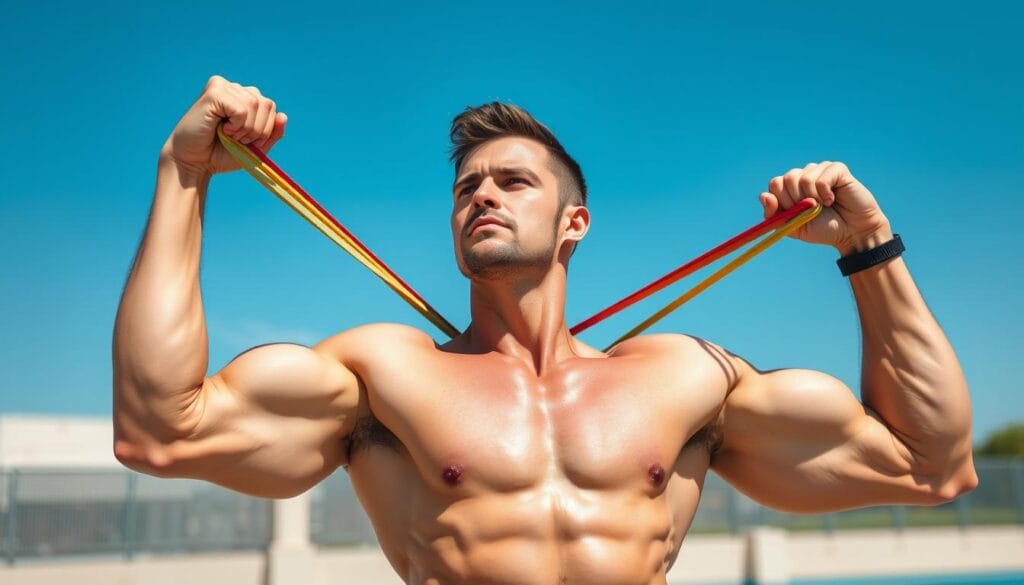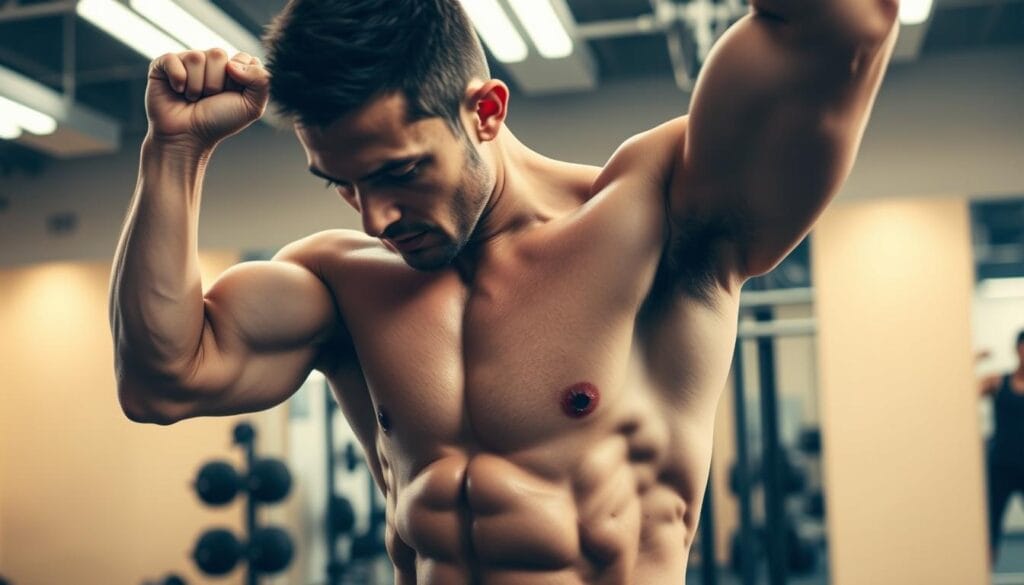Target Your Upper Chest with These Effective Calisthenics Exercises
Every fitness journey starts with one rep. For those aiming to build a strong upper chest, calisthenics is the ideal choice. You can transform your body using just your own weight, without the need for expensive gym memberships or complex equipment.
Upper chest calisthenics are more than just a workout. They lead to strength, flexibility, and personal growth. These exercises are 100% accessible and require no equipment. You can do them anywhere, from your living room to a park, making fitness accessible to all.
Whether you’re new to fitness or have been working out for years, upper chest calisthenics offer a great way to build muscle and enhance your body’s shape. Their simplicity and flexibility allow you to progress at your own speed. You can always find new challenges to keep you motivated.
Table of Contents
Understanding the Importance of the Upper Chest
Understanding the upper chest in calisthenics can change your fitness journey. It’s not just for looks; it’s key for chest strength and function.
To work the upper chest, you need special strategies. The clavicular head of the pectoralis major needs focused attention for growth and definition.
Benefits of Targeting Upper Chest Muscles
- Enhanced muscle definition and symmetry
- Improved posture and shoulder stability
- Increased functional strength for daily activities
- Better athletic performance in pushing movements
*”Precision in upper chest calisthenics can unlock your body’s true muscle development”*
Studies show upper chest fibers are special. They respond well to specific workouts. The best angle for these fibers is 30-45 degrees, with 30 degrees being top for muscle activation.
How Upper Chest Affects Overall Aesthetics
Your upper chest is key for a balanced look. Focusing on upper chest exercises can make your muscles look better and more even.
| Exercise Type | Muscle Engagement | Effectiveness Rating |
|---|---|---|
| Incline Push-Ups | Upper Chest, Anterior Deltoids | High |
| Decline Push-Ups | Upper Chest, Triceps | Moderate-High |
| Wide Push-Ups | Entire Chest, Upper Chest Focus | High |
Knowing how to work the upper chest can make your workouts better. You can target muscle growth more effectively and efficiently.
Essential Anatomy of Your Upper Chest
Knowing your upper chest’s anatomy is key for good upper chest workouts. Your chest muscles are important for strength and a great look.
The pectoralis major muscle is the main muscle for chest movements. Its clavicular head, in the upper chest, is key for upper chest exercises.
Major Muscles Involved
- Clavicular head of pectoralis major
- Anterior deltoid muscle
- Serratus anterior
Each muscle has its own role in building the upper chest. The clavicular head is key for arm elevation and horizontal adduction in upper chest exercises.
How These Muscles Work Together
| Muscle | Primary Function | Role in Upper Chest Training |
|---|---|---|
| Pectoralis Major | Chest Movement | Prime Mover in Pushing Exercises |
| Anterior Deltoid | Arm Elevation | Supports Pressing Movements |
| Serratus Anterior | Scapular Stabilization | Enhances Pushing Power |
Synergy between these muscles creates powerful, coordinated movements during upper chest calisthenics.
Understanding muscle interactions is key to maximizing your workout effectiveness and preventing injuries.
Effective Calisthenics Exercises for Upper Chest
To master upper chest calisthenics, choose the right exercises and focus on technique. Your bodyweight can help build muscle if you know the right moves.
Bodyweight training is great for the upper chest. Studies show it can grow the clavicular head of the pectoralis major. You don’t need expensive gear for this.
Push-Up Variations for Upper Chest Engagement
- Decline Push-Ups: Elevate your feet to shift focus to upper chest muscles
- Diamond Push-Ups: Narrow hand placement increases upper chest activation
- Pike Push-Ups: Vertical positioning targets shoulders and upper chest
Dips: Powerful Upper Chest Muscle Builders
Chest dips on rings or parallel bars work the upper chest well. It’s important to do them right to avoid injury and get the most benefit.
Incline Push-Ups for Targeted Development
| Exercise | Muscle Focus | Difficulty Level |
|---|---|---|
| Standard Incline Push-Up | Upper Chest | Beginner |
| Advanced Archer Push-Up | Upper Chest, Shoulders | Intermediate |
| One-Arm Push-Up Progression | Full Chest, Stabilizer Muscles | Advanced |
*”The key to upper chest development is strategic exercise selection and consistent practice.”*
For upper chest exercises, aim for 30-45 degrees of incline. This angle is best for muscle activation without losing form. Most find 30 degrees works well.
Focus on quality over quantity. Start with easier variations and add more challenge as you get stronger. Your upper chest will grow best with varied, challenging exercises done right.
Adding Resistance to Your Calisthenics Routine
To boost your upper chest workouts, use resistance techniques that push your muscles. Tools like resistance bands and progressive overload can change your bodyweight training.

Adding resistance to your upper chest workouts can really help build muscle and strength. It’s all about knowing how to adjust your training.
Resistance Bands: Your Secret Weapon
Resistance bands are great for upper chest workouts. They offer adjustable tension that works your muscles harder.
- Attach bands to push-up bars for added resistance
- Use bands to create tension during dip variations
- Increase difficulty of standard bodyweight exercises
Progressive Overload Techniques
Progressive overload is key for growing your muscles in upper chest workouts. Here are some ways to challenge your muscles:
| Technique | Implementation | Muscle Impact |
|---|---|---|
| Increased Repetitions | Add 2-3 reps per set | Muscular Endurance |
| Tempo Manipulation | Slow eccentric movements | Muscle Hypertrophy |
| Exercise Variations | Advanced push-up techniques | Muscle Recruitment |
“Resistance is not about complexity, but consistent, strategic challenge.” – Fitness Expert
Using these upper chest techniques can take your muscle growth and strength to new heights. Remember, getting better is a personal journey that needs effort and smart training.
Structuring Your Workout Routine
Creating a good upper chest calisthenics workout needs careful planning and regular practice. Your routine should help build muscle, avoid burnout, and meet your fitness goals.
Designing Your Weekly Training Schedule
A great upper chest calisthenics routine follows a set plan. Here’s a suggested weekly schedule:
- Monday: Upper Body Push Exercises
- Tuesday: Rest or Light Recovery
- Wednesday: Lower Body and Core
- Thursday: Upper Body Pull Exercises
- Friday: Upper Chest Focused Workout
- Saturday: Active Recovery
- Sunday: Complete Rest
Balancing Muscle Group Development
Good upper chest calisthenics training means picking the right exercises. Your workout should include:
- Decline push-ups targeting upper chest muscles
- Parallel bar dips with chest emphasis
- Pike push-ups for shoulder and upper chest engagement
“Consistency is the key to transforming your upper chest through calisthenics.” – Fitness Experts
Set and Rep Recommendations
When doing upper chest calisthenics, follow these tips:
- 3-4 sets per exercise
- 6-15 repetitions per set
- 60-90 seconds rest between sets
- Progressive overload by increasing difficulty every 1-2 weeks
Remember, upper chest calisthenics need patience and commitment. Your muscles will grow and adapt with regular, structured training.
Common Mistakes to Avoid
Getting good at upper chest calisthenics is more than just wanting to. Many people make big mistakes that can hurt their progress and raise the risk of getting hurt.

Poor Form and Technique Pitfalls
Good form is key to doing upper chest calisthenics right. If you ignore how to do it, you could face serious problems:
- Incorrect body alignment during push-ups
- Incomplete range of motion in chest exercises
- Unbalanced muscle engagement
“Precision in movement trumps quantity every single time.” – Fitness Expert
Risks of Overtraining
Your upper chest muscles need smart training. Too much training can mess up your goals and even harm you long-term.
- Recognize signs of muscle fatigue
- Allow sufficient recovery time
- Implement progressive load strategies
Doing upper chest calisthenics right means smart training, not just pushing hard. Knowing your limits and keeping the right technique will help you grow muscle safely and avoid injuries.
Tips for Maximizing Your Workouts
To boost your upper chest calisthenics, you need a good plan for warming up, working out, and cooling down. This helps avoid injuries and helps muscles grow.
Preparing Your Body for Peak Performance
A good warm-up is key for upper chest calisthenics. Start with:
- Dynamic stretching to get blood flowing
- Light exercises for your chest and shoulders
- Slowly increase your movements to wake up muscles
“Proper preparation prevents poor performance” – Fitness Training Principle
Smart Recovery Strategies
Recovery is when muscles really grow during upper chest calisthenics. Use these recovery tips:
- Do static stretches after working out
- Drink plenty of water
- Eat protein within 30 minutes of finishing
- Get enough sleep for muscle repair
Studies show that with the right warm-up and recovery, you can see a 20-30% increase in strength. Your journey in upper chest calisthenics needs patience, smart planning, and wise workout choices.
Nutrition for Muscle Growth
Fueling your upper chest calisthenics journey needs a smart nutrition plan. The right diet boosts muscle growth and recovery, improving your workout results.
Your muscles need the right food to grow and recover well during upper chest calisthenics. Protein is key for muscle repair and growth.
Protein: The Muscle-Building Powerhouse
Protein is vital for muscle growth. Studies show you should eat 1.6-2.2 grams of protein for every kilogram of your body weight each day. Good protein sources include:
- Chicken breast (31g protein per 100g)
- Greek yogurt (20g protein per 200g serving)
- Eggs (6g protein per large egg)
- Lean fish
- Plant-based proteins like tofu and legumes
Best Foods for Upper Chest Development
To help your upper chest calisthenics goals, eat foods rich in nutrients and high-quality protein.
“Nutrition is the foundation of muscle growth. Without proper fuel, your body cannot repair and build muscle effectively.” – Fitness Expert
Include these muscle-building foods in your diet:
- Lean proteins
- Complex carbohydrates
- Healthy fats
- Nutrient-rich vegetables
Remember, muscle growth happens during recovery. Make sure you eat enough calories to support your upper chest calisthenics training and muscle growth.
Tracking Your Progress
Tracking your progress is key for upper chest calisthenics success. By measuring strength gains, you can keep improving and avoid plateaus. Focus on exercises like push-ups to target your upper chest muscles well.
Use volume metrics to track your progress. This means sets, reps, and load. For example, if you start with 8 push-ups and increase to 10 and then 12, you’re using progressive overload. This method shows your muscle growth and helps avoid injuries from intense training.
How to Measure Your Strength Gains
Start by setting a baseline for your upper chest calisthenics. Record reps, time under tension, and exercise difficulty. Use a fitness journal or app to track your progress regularly.
Pay attention to exercises that challenge your upper chest, like incline push-ups or dips. These can give you insights into your strength growth.
Adjusting Your Routine for Continuous Improvement
Listen to your body and adjust your routine as needed. Aim for progress but remember, high-intensity training can lead to injuries. Balance your training with rest, vary intensity, and seek professional advice for a safe and effective fitness journey.

